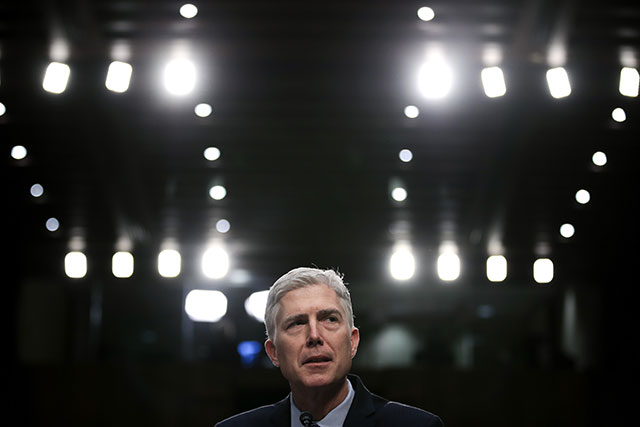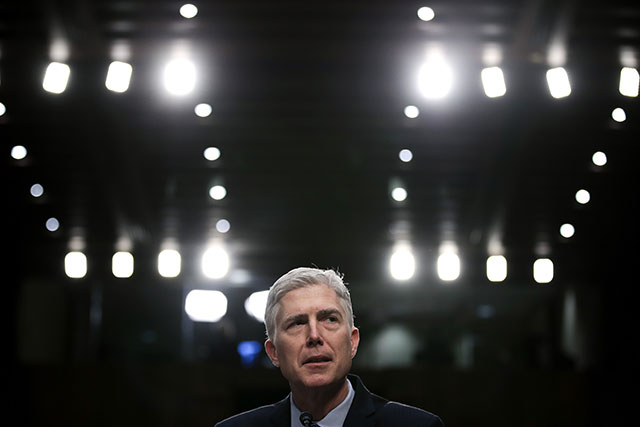
Part of the Series
Human Rights and Global Wrongs
 Judge Neil Gorsuch testifies during second day of his Supreme Court confirmation hearing in the Hart Senate Office Building on Capitol Hill, March 21, 2017, in Washington, DC. The justice who favored torture and warrantless surveillance is also in favor of Trump’s Muslim Ban. (Photo: Drew Angerer / Getty Images)
Judge Neil Gorsuch testifies during second day of his Supreme Court confirmation hearing in the Hart Senate Office Building on Capitol Hill, March 21, 2017, in Washington, DC. The justice who favored torture and warrantless surveillance is also in favor of Trump’s Muslim Ban. (Photo: Drew Angerer / Getty Images)
Help preserve a news source with integrity at its core: Donate to the independent media at Truthout.
The Supreme Court has agreed to hear the first major test of the scope of executive power to protect national security since Neil Gorsuch joined the Court as associate justice.
Monday morning, the high court announced it will determine the legality of Donald Trump’s executive order establishing a Muslim travel ban when it reconvenes the first Monday in October.
In the meantime, the high court allowed parts of the ban to go into effect. Trump can now exclude foreign nationals who lack any bona fide relationship with a person or entity, such as a school, in the United States.
To read more stories like this, visit Human Rights and Global Wrongs.
The high court’s majority ruling was signed “per curiam” (by the court), meaning that no justice took responsibility for writing it. Three justices — Clarence Thomas, Samuel Alito and Neil Gorsuch — dissented from the majority ruling, saying they would have upheld the exclusion of everyone covered by Trump’s ban without limitation. Gorsuch’s dissent, while perhaps not unexpected coming from a person who obediently defended torture, warrantless surveillance and runaway executive power under the Bush administration, portends a far-right tilt for the court’s newest justice.
Trump’s initial travel ban, issued by executive order on January 27, was subsequently struck down by lower courts. On March 6, Trump issued a second, slightly narrower executive order (EO). It said that nationals of six predominantly-Muslim countries “present heightened risks to the security of the United States” and some of those who have entered the US through the immigration system “have proved to be threats to our national security.”
The EO directed that the entry of nationals from the six countries be “suspended for 90 days from the effective date” of the order, to give the administration time to establish “adequate standards … to prevent infiltration by foreign terrorists.”
Two Appellate Courts Had Halted the Travel Ban
Two federal appellate courts stayed the implementation of the ban on travelers from the six Muslim-majority countries — Iran, Libya, Somalia, Sudan, Syria and Yemen — but on different grounds.
In May, the Fourth Circuit ruled in a 10 to 3 decision that the ban on nationals from these countries violated the First Amendment’s Establishment Clause because it was motivated primarily by a desire to exclude Muslims from the United States, not by considerations of national security. The appellate court wrote that the EO “drips with religious intolerance, animus and discrimination,” citing Trump’s campaign statements calling for a “Muslim ban.”
Trump “expressed anti-Muslim sentiment” during the presidential campaign, Chief Judge Roger L. Gregory wrote for the majority. It is entirely plausible, Gregory added, that the EO’s “stated national security interest was provided in bad faith, as a pretext for its religious purpose.”
The Ninth Circuit, on the other hand, didn’t reach the constitutional issue. A unanimous three-judge panel concluded earlier this month that the ban on nationals from the six countries, the suspension of all refugee admissions for 120 days, and the cap of 50,000 on refugees for 2017 exceeded the president’s authority under the Immigration and Nationality Act (INA).
As the panel stated, “the [EO] does not provide a rationale explaining why permitting entry of nationals from the six designated countries under current protocols would be detrimental to the interests of the United States,” which is what the INA requires before the president can “suspend the entry of all aliens or any class of aliens” to the US.
Moreover, the panel wrote, the EO “does not tie these nationals in any way to terrorist organizations within the six designated countries” or “identify these nationals as contributors to active conflict or as those responsible for insecure country conditions. It does not provide any link between an individual’s nationality and their propensity to commit terrorism or their inherent dangerousness.”
“National security is not a ‘talismanic incantation’ that, once invoked, can support any and all exercise of executive power,” the panel added.
The EO also runs afoul of an INA provision that prohibits discrimination in the issuance of immigrant visas “because of the person’s race, sex, nationality, place of birth or place of residence,” according to the panel.
The Supreme Court’s Ruling
In its 13-page order on Monday, the Supreme Court stated, “An American individual or entity that has a bona fide relationship with a particular person seeking to enter the country as a refugee can legitimately claim concrete hardship if that person is excluded.” As to those individuals, the Court left the appellate courts’ injunctions against their exclusion in place.
Individuals with a “bona fide relationship” include those who have a “close familial relationship.” Thus, “[a] foreign national who wishes to enter the United States to live with or visit a family member” cannot be excluded under the EO.
For entities, “the relationship must be formal, documented, and formed in the ordinary course, rather than for the purpose of evading the [EO].” Students from the designated countries who have been admitted to a US university have such a relationship. Workers who have accepted employment from a US company or a lecturer invited to address a US audience are also covered.
The Court directed the parties to address the issue of whether the challenges to the EO became moot on June 14, 2017, the end date of the EO’s 90-day suspension period.
Thomas’s dissent, joined by Alito and Gorsuch, concluded that the Trump administration “made a strong showing that it is likely to succeed on the merits” and that “failure to stay the injunctions will cause irreparable harm by interfering with ‘its compelling need to provide for the Nation’s security.'”
The dissenters feared “that the Court’s remedy will prove unworkable” because government officials will have to decide whether those who seek to enter the US have sufficient connections to a person or entity in the US. “The compromise also will invite a flood of litigation until this case is finally resolved on the merits, as parties and courts struggle to determine what exactly constitutes a ‘bona fide relationship,’ who precisely has a ‘credible claim’ to that relationship, and whether the claimed relationship was formed ‘simply to avoid'” the EO, Thomas wrote (quoting from the per curiam order).
This is precisely why the Court should’ve put a hold on the entire travel ban pending its decision on the merits next term.
The Case Will Test the Limits of Executive Power
This case sets the stage for a major ruling on the scope and limits of presidential power in the context of national security.
During the Bush administration, the high court told the executive he could not deny Guantánamo detainees their right to habeas corpus. But the Court held during the Obama administration that people could be charged with providing material support for terrorism even if one purpose of the charity to which they donated supported humanitarian work.
Gorsuch’s joinder with Thomas and Alito in allowing Trump to fully implement his Muslim ban portends the new justice’s strong deference to the executive.
When he worked in Bush’s Justice Department, Gorsuch dutifully argued against Guantánamo detainees who sought to bring habeas corpus petitions to challenge their detention, opposed the Detainee Treatment Act’s prohibition of cruel treatment, argued that “enhanced interrogation” (a euphemism for torture) works and defended Bush’s warrantless surveillance program. At his confirmation hearing, Gorsuch said he was just following orders.
This case will reveal in more depth Gorsuch’s willingness to unconditionally defer to the executive.
In three months, the justices will grapple with whether Trump’s EO violates the First Amendment and/or the INA. And since US district court judges in New York and Massachusetts concluded it was likely that Trump’s first EO violated due process and equal protection, the Court may also decide whether the second EO contravenes the Due Process and Equal Protection Clauses.
It is also possible the Court will conclude the issue is moot, because the suspension on entry of travelers from the six Muslim-majority countries expired on June 14, 2017, by its own terms. On June 14, however, Trump amended his March 6 order to say that the ban would take effect after the lower court orders halting its implementation were lifted. That would mean the issue is still alive. We will see whether the Supreme Court decides the issue on its legal merits and defines the scope of executive power in national security matters, or dismisses the case as moot.
Meanwhile, we would do well to note the significance of Gorsuch’s affirmation of unbridled executive power.
Our most important fundraising appeal of the year
December is the most critical time of year for Truthout, because our nonprofit news is funded almost entirely by individual donations from readers like you. So before you navigate away, we ask that you take just a second to support Truthout with a tax-deductible donation.
This year is a little different. We are up against a far-reaching, wide-scale attack on press freedom coming from the Trump administration. 2025 was a year of frightening censorship, news industry corporate consolidation, and worsening financial conditions for progressive nonprofits across the board.
We can only resist Trump’s agenda by cultivating a strong base of support. The right-wing mediasphere is funded comfortably by billionaire owners and venture capitalist philanthropists. At Truthout, we have you.
We’ve set an ambitious target for our year-end campaign — a goal of $225,000 to keep up our fight against authoritarianism in 2026. Please take a meaningful action in this fight: make a one-time or monthly donation to Truthout before December 31. If you have the means, please dig deep.